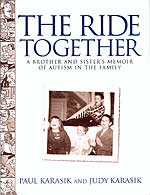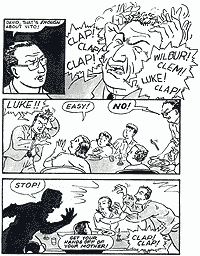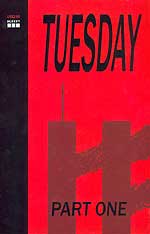
|
"The Ride Together: A Brother and Sister's Memoir of Autism in the Family (Washington Square Press; 200 pp.; $20) by Judy and Paul Karasik alternates prose chapters written by Judy with comix by Paul. The resulting tag-team style provides two sides of a family's story of growing up with an autistic older brother. David Karasik, born in the 1940s, was first diagnosed as having "aphasia," or being "brain damaged," long before autism became a concept that TIME magazine would put on its cover. As the Karasiks describe him, David struggles to put order to a world that arrives in splinters. To help him do so he comes up with systems. Clearly a fundamentally creative and intelligent person, he fills reams of paper with writing that can then be organized and reorganized. He obsesses over names, memorizing the full legal name of every member of congress who has served from the 1950s to the present. Most fascinating of all, he performs versions of "Meet the Press" and "Face the Nation" starring these politicos. He performs other shows as well, like the old "Superman" series, in condensed but otherwise verbatim versions that go on at regular schedules.
But, as the title indicates, "Ride Together" focuses less on the particular mysteries of David in favor of the more general family history which included him. So we get chapters about Paul's pranks at school, family poker games and the arrival of an elderly aunt. The warm-heartedness of the Karasik family (the parents became advocates for the mentally disabled) extends out of the page and pulls you in. In an age of broken families the Karasik's generous spirit can be quite moving. Still, it's David who sets the family apart, and when he disappears into the background the book becomes much less compelling. He's a vivid character — a mystery that we as readers want to have solved but never can.
 David Karasik becomes agitated, bursting out the frame in "The Ride Together"
David Karasik becomes agitated, bursting out the frame in "The Ride Together" |
The comix chapters by Paul Karasik (a former associate editor of "RAW" magazine and co-author of the graphic novel version of Paul Auster's "City of Glass") get as close to an explanation of David's inner life one can hope to. One clever chapter is narrated by Gorilla Watson, an "Adventures of Superman" bad guy who David refers to repeatedly. Gorilla explains that while everything outside David's head is splintered, "Inside it's as tidy and rich as Fort Knox." At the end, in a sad twist the final panel shows Gorilla behind bars with David, calling him, "the best roommate a fella could want." This sort of visual editorial is what separates comix memoir from prose. But while Paul Karasik does a nice enough job of relating his brother's illness, his approach seems conservative compared to last year's intensely ambitious and beautiful "Epileptic," by David B. Also a memoir about a brother's mental illness, "Epileptic" dared to go beyond exploring the brother's malady, using it as a tool to explore the author's own mental issues.

|
Henrik Rehr's "Tuesday" (Kim-Rehr Productions; 24pp.; $2.95 each) is a two-issue series that recounts the author's experience of September 11, 2001. Living with his wife and two young sons in the Battery Park City complex of apartment buildings that were mere blocks from the catastrophe, his story gives a first-hand account of the chaos visited on lower Manhattan that day. While there have been many memoir comix about 9/11 (see TIME.comix reviews: part one; part two), most of them recount the mediated experience of those outside of ground zero. "Tuesday" gives us the first detailed, longform story of living through that nightmarish experience.
Separated from his wife, who went to work, and oldest son, who went to school, the first book tells of Rehr's escape from lower Manhattan. In a typically dramatic moment Rehr must wait inside the lobby of his building with his asthmatic toddler while the space fills with dust from the collapsed buildings. Eventually reconnecting with the rest of his family, part two covers their homeless life in the months after the disaster, a 9/11 story rarely heard about. Rehr tells of bouncing from one temporary living arrangement to another while struggling to find out information on the state of their building. Allowed back in their apartment for ten minutes, he finds his coffee cup still waiting, frozen in dust.
 Henrik Rehr flees through the rubble of downtown in "Tuesday"
Henrik Rehr flees through the rubble of downtown in "Tuesday" |
Hitherto unknown, at least by me, Henrik Rehr seems to have come from nowhere with a natural, realist drawing technique and a clear, seemingly effortless narrative style. Wisely conservative, Rehr knows that the dramas of that day need no enhancements. The advantage of drawing such events seems clear: they are indescribable. It really has to be seen to be believed. But Rehr doesn't just focus on the external, he smartly takes time out for flashbacks and interior monologues, giving variety to the storytelling and visuals. While the ultimate lesson of Henrik Rehr's "Tuesday" may not be new, it remains profound and moving: the importance of community and family.
Written in a visual language that would otherwise have taken up thousands of words of prose, comix allow not only for a more efficient and less expensive approach to memoir, but a richer one as well. "Ride Together" and "Tuesday" are just two fine examples of this arguably superior method of relating personal history.
"Ride Together" can be found at any regular bookstore. "Tuesday" can be found at superior comic stores.
